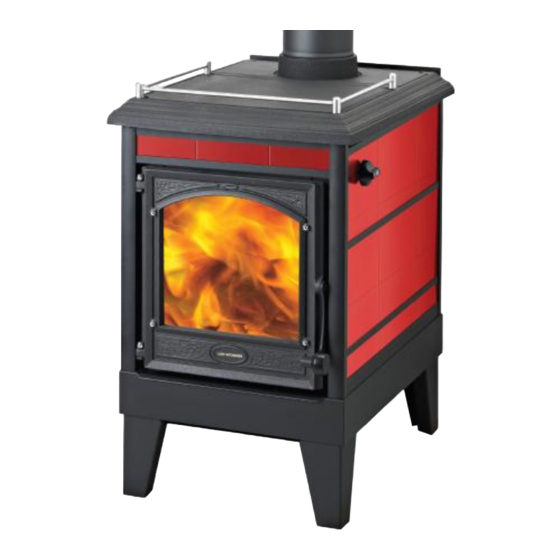Firenzo Lady Kitchener Gebruiksaanwijzing - Pagina 5
Blader online of download pdf Gebruiksaanwijzing voor {categorie_naam} Firenzo Lady Kitchener. Firenzo Lady Kitchener 9 pagina's. Freestanding woodburner
Ook voor Firenzo Lady Kitchener: Handmatig (10 pagina's), Instructies voor installatiehandleiding (8 pagina's)

5
used once the moisture is less than 20%. During the EN test, all stoves are tested with wood with a moisture
content of 16 (± 4%).
Never use driftwood as it usually has a high salt content, which damages both the stove and the chimney.
Impregnated and painted wood and chipboard emit poisonous smoke and fumes so they should not be used as
fuel either.
Please note that liquid fuel may not be used in the stove. It must also not be used as an incinerator.
The first few times you light the stove, the fire should be moderate so that the heat-resistant paint can harden
before firing more vigorously. During the hardening phase, the paint may develop obnoxious smoke and smell the
first time it is lit, which is very normal. Make sure that the room is well ventilated during this period.
6.1 Lighting instructions and fuelling intervals
Kindling requires a large flow of air. When kindling a cold stove, it is useful to leave the door ajar the first few
minutes and open the combustion air supply completely. In order to build up an insulating layer of ashes in the
bottom of the stove, it is recommended that you burn off 1-1.5 kg (2-3 pounds) of kindling wood the first time you
use the stove. Thereafter, always keep a 20mm bed of ashes in the bottom of the combustion chamber.
1. The layer of embers is formed quickly when lit with 2 kindling tablets or similar together with approx. 1-1.5 kg of
dry kindling. Place the kindling sachets evenly under the top layer of kindling.
2. Open the air supply control completely i.e. turn the air control knob on the right side of the fire to „HI‟.
3. After the paper/solid alcohol tablets have caught fire, leave the fire door ajar so that the chimney draws well.
4. When you can see that the chimney is hot enough to draw (after 5-10 minutes), close the door. If all the
necessary conditions are met; a thick layer of embers will have been formed in the combustion chamber after
another 15-20 minutes.
5. Re-stoking should normally be carried out while embers still remain. Distribute the embers in the bottom,
ensuring that most of them are at the front of the stove.
6. The appliance works best with 4 logs, approximately 225 – 300 mm long, loaded front to back. Under normal
modes of operation, this fuel should last about 1 hour.
7. When reloading wood do not over-fill the fire box. Only load to approximately half of the capacity of the firebox.
8. Open the air supply to maximum and close the door; the fresh wood will then ignite within a couple of minutes.
9. Reduce the amount of combustion air to the desired position, and optimal combustion will continue until there
are glowing embers in the bed. During the nominal test, the stoking interval was about 60 minutes.
10. A new portion of wood can be added by repeating steps 5 & 6.
The stove door should normally be opened gently the first 2-3 cm, then you should wait until the pressure has
equalised before opening the door all the way. This technique will prevent smoke from getting out, particularly
when there is a poor draught.
The stove is designed to be operated with the door closed. It should only be open when igniting and reloading.
Operation with the air controls or appliance dampers open can cause excess smoke. The appliance must not be
operated with air controls, appliance dampers or door left open except as directed in the instructions.
Once the wood has burned out, it becomes glowing charcoal. If a good layer of embers has already formed on
top of a sufficient layer of ash, the stove can keep warm for a very long time, not least due to the favourable
qualities of the cast iron.
We would strongly recommend that you do not leave your stove alit at night. It harms the environment and
constitutes very poor use of the wood as the gases in the wood do not ignite at the low temperature, but settle as
soot (unburned gases) in the chimney and stove. Extreme conditions, such as poor draught in the chimney, large
quantities of wood or wet wood, may in the worst-case scenario cause an explosive ignition.
When firing in the summer period, when there is minimal need for heat, the combustion will be poor. The stove
provides too much heat so the combustion should be reduced. But always remember to make sure that there are
lasting flames until the wood becomes charcoal. If you want a weaker fire, stoke up using less wood.
If you fire the stove using wet wood, a lot of the fuel‟s thermal energy will be spent forcing the water out of the
wood, without releasing any heat to the stove. This incomplete combustion results in a layer of soot being left in
the stove, pipe and chimney.
CU-2013-05-14
